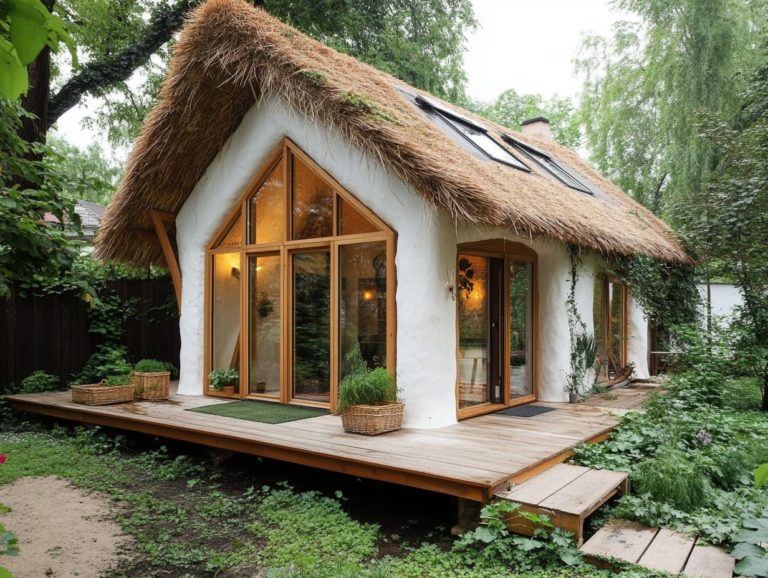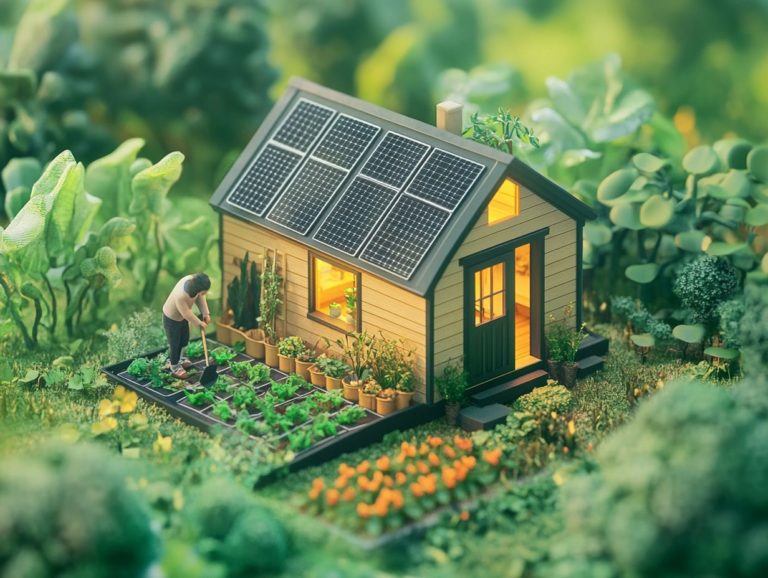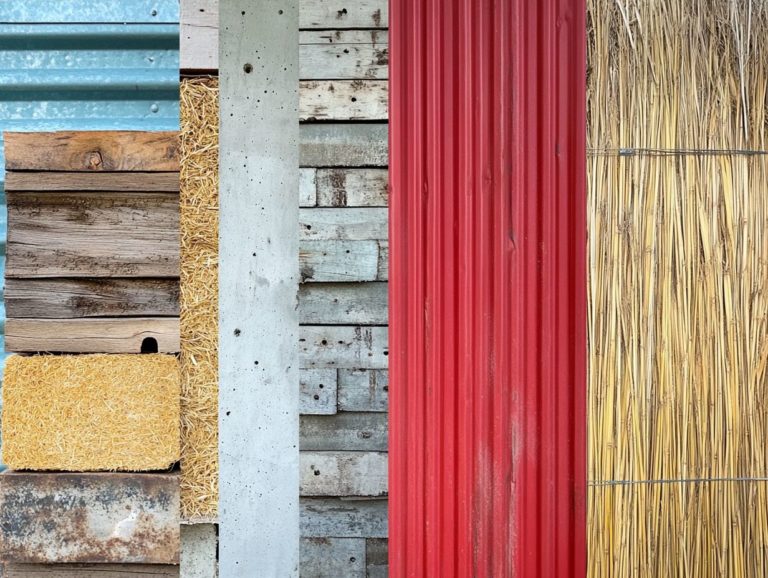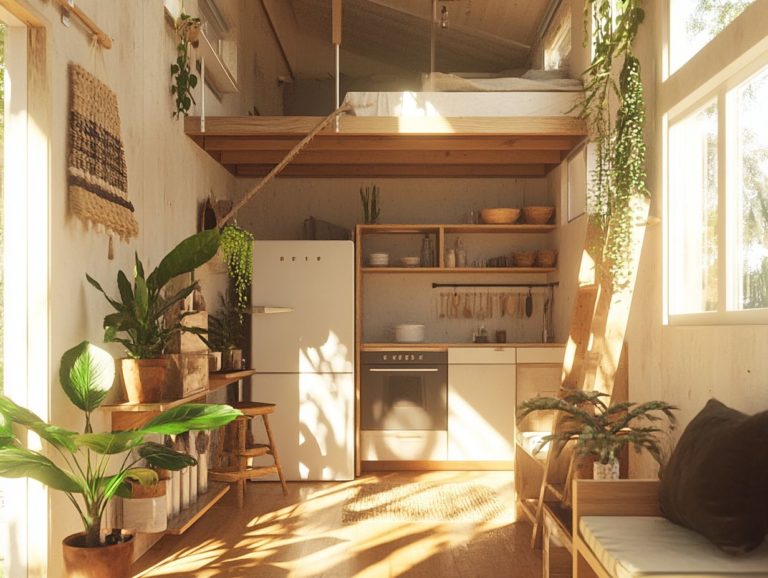The Benefits of Using Non-Toxic Materials in Tiny Living
Tiny living transcends mere trend; it embodies a lifestyle choice that champions simplicity and sustainability.
As you embrace this compact way of life, the significance of utilizing non-toxic materials becomes ever more apparent.
This exploration delves into the rise of tiny living, the potential health risks associated with small spaces, and the myriad benefits of opting for non-toxic materials.
From enhancing your well-being to safeguarding the environment, uncover how intentional choices can elevate your tiny living experience.
Contents [hide]
- Key Takeaways:
- The Rise of Tiny Living
- The Importance of Non-Toxic Materials in Tiny Living
- Benefits of Using Non-Toxic Materials
- Examples of Non-Toxic Materials for Tiny Living
- How to Incorporate Non-Toxic Materials in Tiny Living
- Frequently Asked Questions
- What are the benefits of using non-toxic materials in tiny living?
- How do non-toxic materials promote better indoor air quality in tiny living spaces?
- What are some common health issues that can be prevented by using non-toxic materials in tiny living?
- Are there any financial benefits to using non-toxic materials in tiny living?
- How can using non-toxic materials in tiny living be environmentally friendly, considering carbon emissions?
- What are some examples of non-toxic materials that can be used in tiny living, including options like rammed earth, hempcrete, and cordwood?
Key Takeaways:
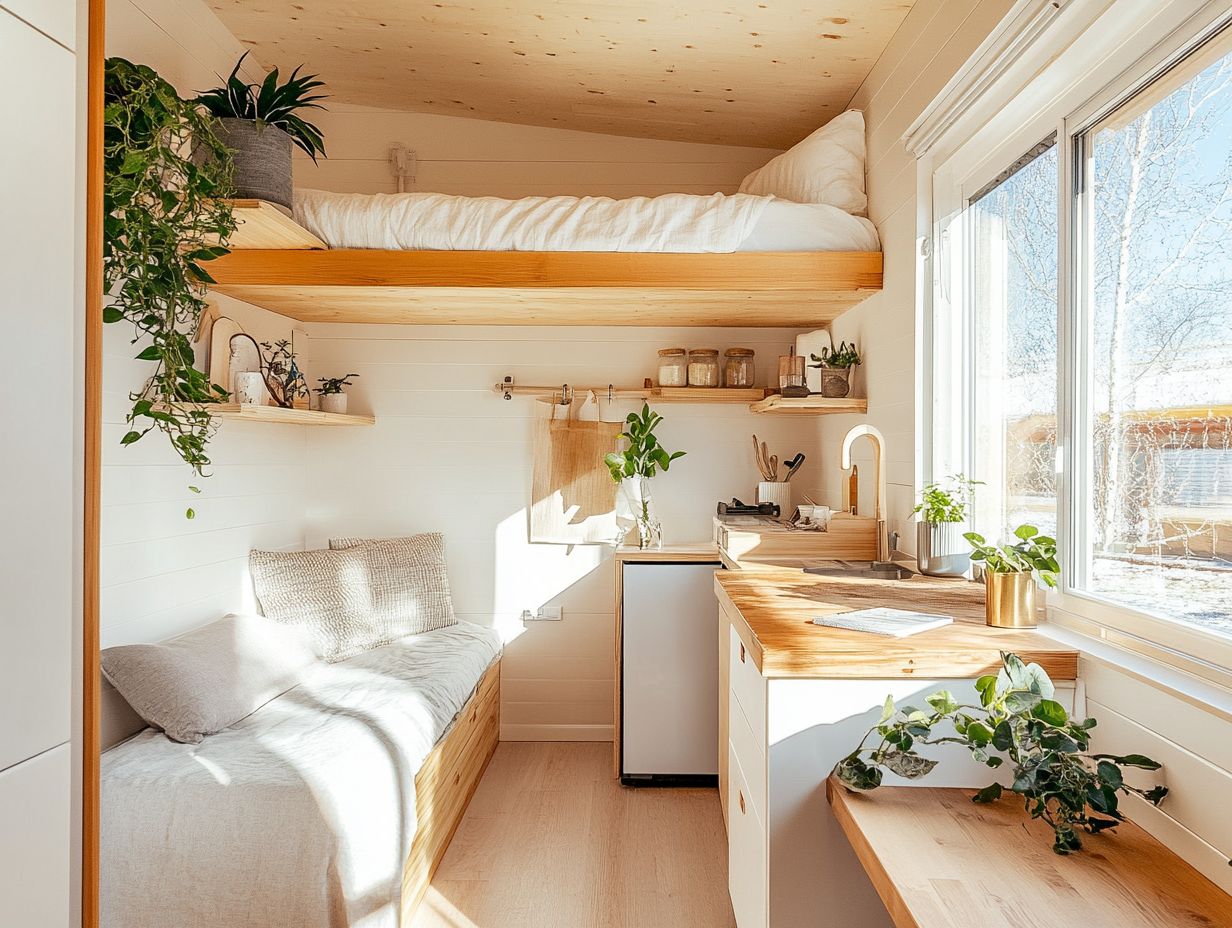
- Living in a tiny space doesn’t mean compromising on health. Non-toxic materials minimize health risks and make tiny living safer.
- Using non-toxic materials also benefits the environment. Natural and sustainable options reduce your carbon footprint.
- Incorporating non-toxic materials is easy. With a bit of research, you can create a healthier and more sustainable tiny home.
The Rise of Tiny Living
The rise of tiny living represents a transformative trend. It signals a shift towards smaller, more sustainable homes.
These homes embrace a minimalistic lifestyle and embody caring for the environment and resource conservation.
As you navigate the challenges of rising housing costs and environmental degradation, tiny homes have emerged as a compelling solution.
By using energy-saving methods and sustainable materials, they effectively reduce carbon footprints while enhancing indoor air quality and your overall well-being.
Explaining the Trend and its Impact
Tiny living is all about downsizing, and it s sparking excitement in communities everywhere. It highlights the significance of fostering community while minimizing your ecological footprint.
When you embrace a tiny home, you often experience considerable financial relief. The average cost of a tiny house hovers around $30,000 starkly contrasting with the median U.S. home price of about $350,000.
This remarkable difference allows you to redirect your funds toward enriching experiences rather than accumulating material possessions.
Tiny living naturally encourages sustainable practices, with many opting for minimalism and waste reduction. Tiny homeowners typically generate 50% less waste than those in traditional homes.
A study conducted by the Tiny House Community revealed that residents reported lower energy consumption, frequently achieving savings of 20% on utilities.
By cultivating a deeper connection to your surroundings, you’re not merely making a statement about your lifestyle choices; you’re actively contributing to a more sustainable future.
The Importance of Non-Toxic Materials in Tiny Living
In the realm of tiny living, the significance of non-toxic materials truly cannot be overstated. These materials are essential for maintaining both indoor air quality and the overall health of those who inhabit these spaces.
By choosing options like rammed earth, hempcrete, and cordwood, you enhance the environmental benefits of your tiny home while embracing a sustainable lifestyle founded on resource conservation and safety. For more insights, explore The Future of Sustainable Materials in Tiny Housing.
Potential Health Risks in Small Spaces
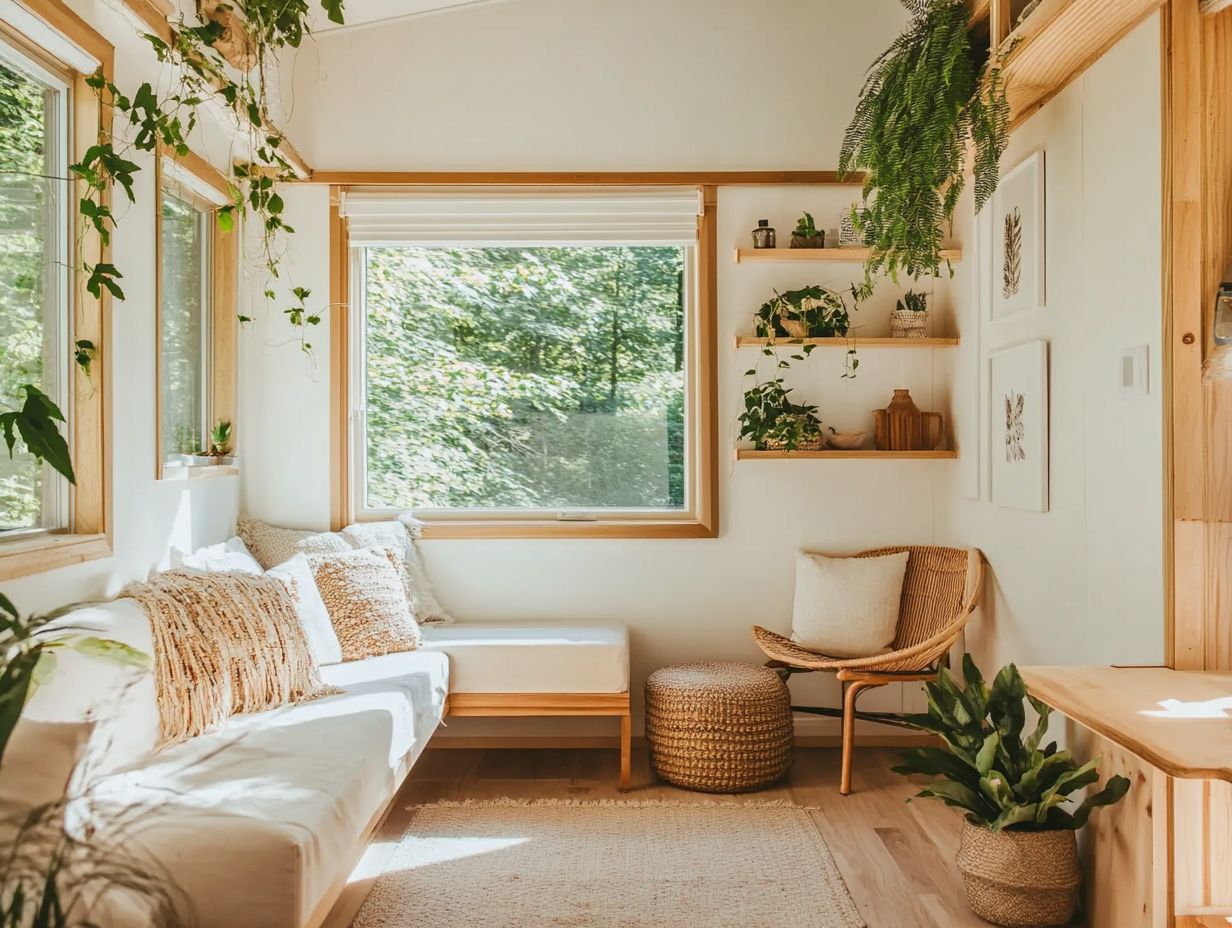
Living in small spaces can present health risks if you don’t carefully consider the materials used. Poor indoor air quality can lead to various health issues, making the choice of non-toxic products in tiny homes essential.
In densely populated urban areas, many individuals unknowingly expose themselves to harmful pollutants and allergens. These can worsen conditions like asthma and allergies. Research shows that indoor air can be more contaminated than outdoor air, particularly in compact living environments with limited ventilation.
By adopting non-toxic materials, you enhance the ambiance of your tiny home and significantly reduce exposure to harmful gases that can come from common household products. Homeowners who choose eco-friendly furnishings often enjoy improved respiratory health and overall well-being.
Advocating for safe materials is crucial in creating healthier living spaces that promote long-term wellness.
Benefits of Using Non-Toxic Materials
The benefits of incorporating non-toxic materials in tiny living go far beyond mere aesthetics. They play a crucial role in enhancing your health and safeguarding the environment, championing a sustainable lifestyle while minimizing waste production.
Health Benefits for Occupants
For those residing in tiny homes, the health benefits of using non-toxic products are strikingly evident. These materials enhance indoor air quality and overall well-being.
Choosing non-toxic options significantly diminishes the presence of allergens, toxins, and pollutants that often hide in conventional furnishings and finishes. This conscious decision elevates your living space and lays the groundwork for lasting health benefits.
A reduced exposure to harmful substances can lead to fewer respiratory issues, skin irritations, and other chronic conditions. Embracing sustainable living practices cultivates a lifestyle that reflects ecological mindfulness.
By selecting materials that are safe for you and gentle on the planet, you can craft a serene sanctuary that nurtures both your personal health and a sense of environmental responsibility.
Environmental Benefits
The environmental benefits of incorporating sustainable materials into tiny homes are extensive. They foster waste reduction and resource conservation while minimizing your ecological footprint.
By choosing bamboo flooring, reclaimed wood, and recycled metal for roofing, these compact living spaces elevate aesthetic appeal and reduce carbon emissions. Bamboo, for instance, absorbs more carbon dioxide than traditional hardwoods, making it an exceptional alternative.
Opting for energy-efficient appliances and solar panels further lessens reliance on fossil fuels. Every eco-friendly decision you make within these tiny habitats accelerates the journey toward a more sustainable future.
Examples of Non-Toxic Materials for Tiny Living
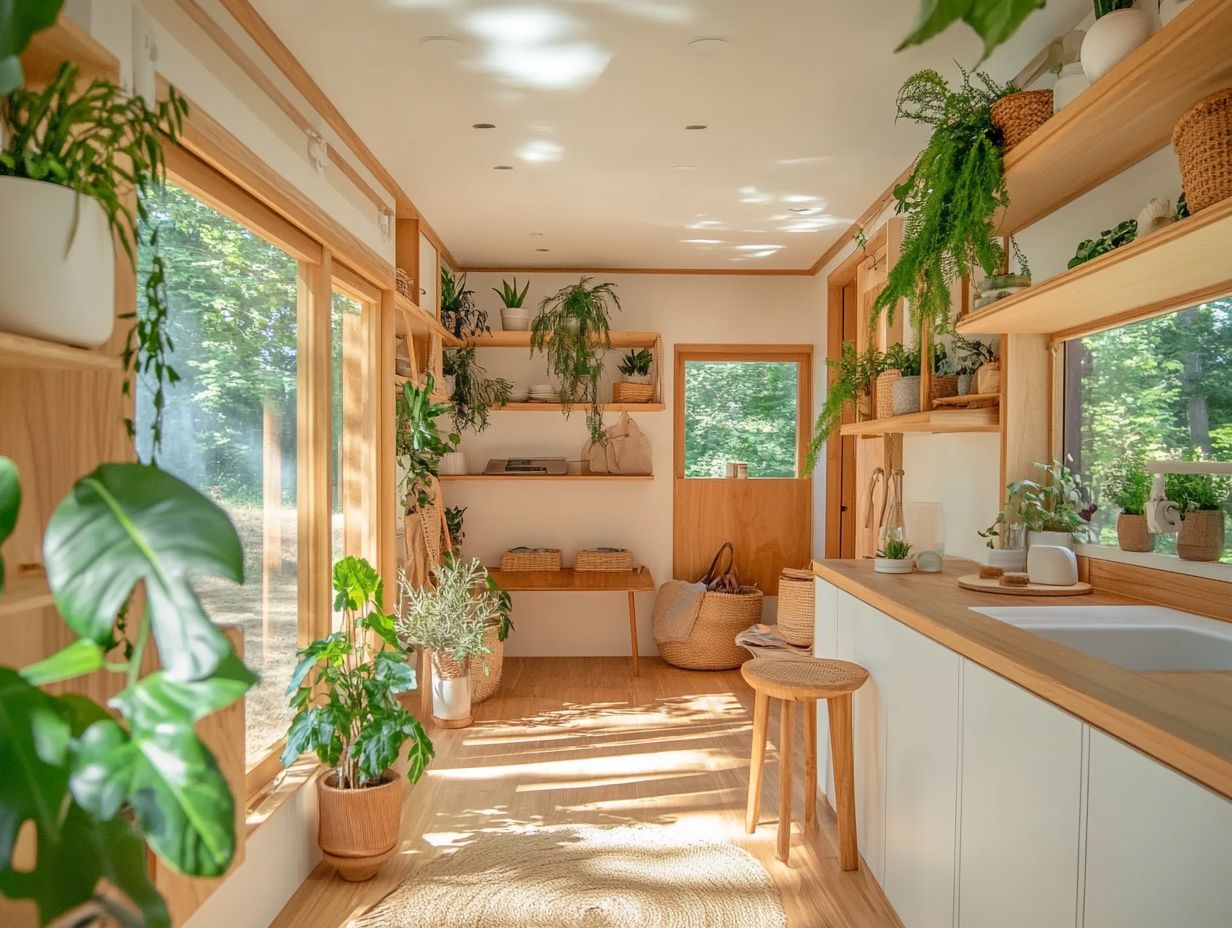
When you explore examples of non-toxic materials for tiny living, you’ll discover a wealth of options, such as rammed earth, hempcrete, and cordwood. These materials resonate with sustainable living principles and champion natural building practices.
By using such materials, you enhance your connection to the environment while creating a healthy home. Act now to protect your home’s air quality!
Start making changes in your own home for better health and sustainability.
Natural and Sustainable Options
Natural and sustainable options like rammed earth, hempcrete, and cordwood present innovative solutions for building tiny homes. These materials are visually stunning and eco-friendly.
These materials enhance the aesthetic charm of your tiny home. They significantly contribute to a smaller carbon footprint, aligning your lifestyle with the principles of environmental stewardship.
For instance, rammed earth leverages locally sourced soils. This provides excellent thermal mass, which means the ability of a material to store heat, effectively regulating indoor temperatures and reducing energy consumption.
Hempcrete is made from hemp fibers and lime. It s lightweight and has great insulation, which boosts your home’s energy efficiency.
Similarly, cordwood construction utilizes recycled wood. This allows for creative, rustic designs that also prioritize waste reduction.
Explore inspiring real-world examples now! Discover how these materials can transform your living space, such as projects in eco-villages or sustainable communities. They seamlessly blend design and sustainability, paving the way for a more environmentally conscious way of living.
How to Incorporate Non-Toxic Materials in Tiny Living
Planning your tiny living space with non-toxic materials is exciting! Every choice reflects your values and boosts your well-being.
You must ensure that every detail, from the construction materials you choose to the efficient appliances you select, aligns seamlessly with the principles of sustainability and health.
It’s about creating a harmonious environment that promotes well-being.
Tips for Choosing and Implementing Materials
When choosing materials for tiny living, opt for non-toxic products and sustainable materials. This creates a safe and environmentally responsible home.
Selecting high-quality materials that are both eco-friendly and healthy can significantly enhance your living experience.
Consider brands like Miyabi, renowned for their sustainable bamboo products, or look for GreenGuard-approved paints that ensure low chemical emissions.
Prioritizing items with certifications like the Forest Stewardship Council (FSC) for wood or the Global Organic Textile Standard (GOTS) for fabrics shows your commitment to eco-conscious choices.
By embracing these practices, you re fostering a healthier living environment and contributing to a broader movement toward sustainability. This makes tiny home living more than just a trend; it becomes a responsible lifestyle choice.
Frequently Asked Questions

What are the benefits of using non-toxic materials in tiny living?
Using non-toxic materials in tiny living has numerous benefits. These include promoting better indoor air quality, reducing the risk of health issues, and being environmentally friendly.
How do non-toxic materials promote better indoor air quality in tiny living spaces?
Non-toxic materials do not emit harmful chemicals, fumes, or volatile organic compounds (VOCs) that can pollute the air in a small living space. This helps maintain a healthy and clean environment for the occupants.
What are some common health issues that can be prevented by using non-toxic materials in tiny living?
Some common health issues that can be prevented include allergic reactions, respiratory problems, and skin irritations. This is especially important for individuals with sensitivities or allergies.
Are there any financial benefits to using non-toxic materials in tiny living?
Yes, non-toxic materials are often more durable and have a longer lifespan. This reduces the need for frequent replacements and repairs, saving money in the long run.
How can using non-toxic materials in tiny living be environmentally friendly, considering carbon emissions?
Non-toxic materials are often made from sustainable and renewable resources. They also do not release harmful chemicals into the environment, making them a more environmentally friendly choice for tiny living.
What are some examples of non-toxic materials that can be used in tiny living, including options like rammed earth, hempcrete, and cordwood?
Imagine your tiny home built with safe materials like bamboo, cork, and organic cotton.
You can also use low or zero VOC paints and finishes to make your space even healthier and more vibrant!
Start your tiny living journey with these amazing materials today!


